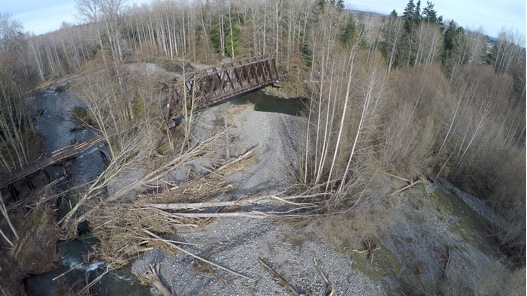
Trestle Damage & Repair Railroad Bridge Park, Sequim WA Information and status as of Mar 30th 2015
Background
Heavy rains caused near flood stage in the Dungeness River on February 5th- 8th 2015. The high water levels and rapid currents toppled numerous large trees and caused woody debris to redirect the river’s braided channels and to carry trees and root wads down stream at high velocities. The water levels and debris load over-stressed timber pilings supporting the the timber trestle to west of the Historic Howe Truss Bridge. Three bents of the trestle and the walkway were damaged causing the closure of the bridge.
The Jamestown S’Klallam Tribe owns the land and the facilities at Railroad Bridge Park, including the Howe Truss Bridge and the trestle. The Tribe maintains the Park’s facilities and opens the park to the public for recreation and education. The Tribe also strongly supports the Olympic Discovery Trail, a regional trail system which will eventually stretch from Port Townsend to LaPush. A critical link of the Trail is at the heart of the Park and uses the bridge and trestle to provide a bicycle and pedestrian river crossing.
The modified former railroad bridge provides the only non-motorized crossing of the Dungeness River. The Park is very popular with residents and visitors. Counting devices on the bridge annually record over 100,000 crossings of the bridge. The Park, bridge and trestle are important economic drivers, commuting routes, tourist attractions, recreational facilities, and educational resources.
The extent of Damage
High water and debris pressure caused failure of the pile bent (a set of five creosote-treated timber piles with cross bracing) at point 34 (DR Bridge Inspection Grid layout). On Friday February 6, 2015 at approximately 1:30 pm one pile of this bent became loose (assessed to be the result of hydraulic scouring) and floated away. The bridge was immediately closed to insure safety of public; approach access was barricaded to prevent use. Over the weekend the remaining piles of bent 34 were scoured out and also floated down river. Adjacent pile bents 33 and 35 became seriously undermined and weakened.
As waters receded, the Dungeness River revealed that it had established a new main channel to the west and straight below the west trestle in the area of pile bents 33-35.
• On Monday, February 9, 2015, Jamestown Tribe (Jamestown Excavating) performed an immediate response to lash trestle pieces together to preclude further creosote-treated timber from entering the river. Out of pocket COST – $5000
• Tribal staff urgently alerted Federal Highways Administration staff, BIA staff and FEMA contacts regarding emergency response and what funding might be available. To-date emergency funding is unlikely, as the damage to the trestle doesn’t reach minimum damage threshold amounts.
• Relevant elected officials were notified including 6th Dist. Rep, Derek Kilmer, WA Senator, Patty Murray, and 24th Dist. WA Legislator, Steve Tharinger. Kilmer and Tharinger responded offering to help.
• Tribal staff began looking for funding from state agencies including Recreation and Conservation Office (RCO) – Salmon Recovery Funding Board (SRFB) and the Department of Natural Resources (DNR). Responses – RCO has no emergency program but did have funding returned from our area for salmon recovery purposes which we could apply for through competitive process. Staff submitted an application with a request for an early decision. This salmon recovery funding will hopefully cover design and permitting (about $150,000) and be available in early May 2015. Additionally, an application has been prepared for salmon funding for construction of the bridge. Cost will be driven by design, but is anticipated to be $1.5 -$2 million. The Tribe plans to determine if DNR can assist with creosote-treated timber pile removal.
• JST staff contacted the Tribe’s insurance company to start an urgent damage claim. Coverage and deductible amounts pending review by JST insurance carrier. An adjuster and an engineer from the insurance carrier have visited the site and are determining the estimated cost of repairs that can be covered under the Tribe’s policy.
• Short term repair –The cost to repair the damaged trestle section to an “as was” condition ranges from $284,000 to $327,000
• Long term replacement – The estimated cost to replace the existing trestle with an updated design is estimated at $2 million. A local engineering firm has provided informal cost estimates.
Repair and replacement proposals under consideration, (Tribe seeks funds for both):
• Short term repair – Open the Dungeness River crossing to the public ASAP until a permanent replacement project is designed, funded, and ready to construct…up to $327,000
• Long term repair & replacement – to construct a revised structure that would allow the river to flow, with fewer impediments, under this crossing. Replace the current creosoted wood pile bents spaced 16’ apart, with a deck support system more compatible and less toxic to the environment…up to $2 million
Note: This status report will be updated and reposted to the JST Tribal, and the River Center websites as new information on funding and status of repair work becomes known.

